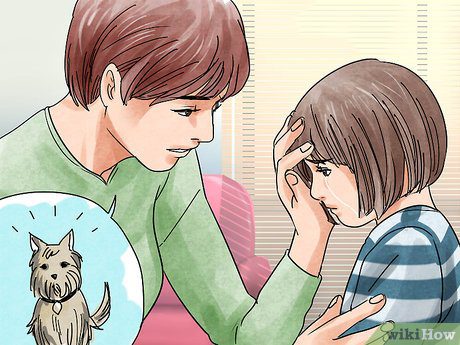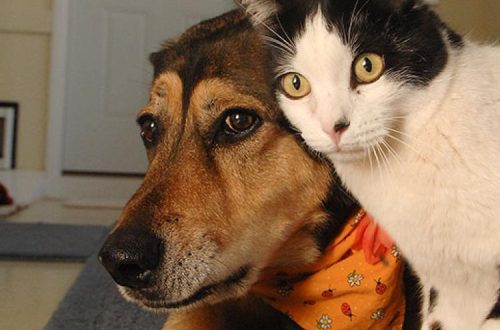
What to tell a child if a cat or dog has died?
Recently you heard: “Mom, where is my dog? Why doesn’t she live with us anymore? Will you leave too and never come back like her?” When a dog dies in the family, children often have a lot of questions and it can be difficult to figure out how to answer them. Explaining the death of a pet to a child is never an easy task. Depending on their age, mourning the loss of a dog (or impending death) can cause extreme confusion, not to mention depression, and children need the help of their parents to deal with the situation. But where to start? What to say? Everyone has their own approach to how to tell the child this news, and this is normal. If you don’t know how to explain loss to your kids, these three tips can help.
Contents
1. Be honest.
You may want to soften the news of your dog’s death, especially if your children are still young. You might find it much easier to turn the truth around and tell them that their beloved pet should take care of another family in need, or that he followed his dream and set off to explore the wild jungles of Australia, but stories like this aren’t always the best way out. . Although some people claim that children are smarter than they seem, the truth is that they understand a lot more intuitively, and not intellectually, as adults believe.
You know better how much truth you should tell your children, but directness will help the child understand the situation and begin to sort out his feelings. After all, death is an important part of life. Your children will experience this sooner or later, both as children and as adults, and although death is never an easy experience, learning about it in a safe environment will help them cope with future losses.
Remember that honesty doesn’t necessarily mean you have to give all the details. Choose the wording that is most comfortable for you, be sure to use the word with an “s” (as in the word “death”), but skip any gory details. If you’re a religious person or need a way to soften the blow, you can mention that she’s gone to dog heaven, but it’s better to explain what that means in terms of your dog’s life. Don’t mislead a child by telling him that his beloved dog is somewhere else, wandering the world, as he will only get worse when he realizes the truth.
If your pet is still alive, talk to the children about his illness or injury before he dies. Explaining the death of a pet to a child is much easier if your son or daughter knows it’s inevitable and isn’t surprised by the news. However, sometimes accidents happen and some dogs die in their sleep. In this case, be patient when answering endless questions about whether your furry friend will return and choose your words carefully.
2. Acknowledge your children’s feelings.
When explaining the death of a pet to your child, be prepared for a wide range of emotions. Your children may burst into tears, become hysterical, or even simply ignore your announcement. All these feelings and actions are a way of digesting the news. Young children are still learning to recognize their emotions, so they often turn to their parents to understand exactly how they feel. Mourning the death of a dog is hard work, so acknowledge their emotions whether or not you feel the same way. According to the Kübler-Ross model of grief, people go through five stages: denial, anger, bargaining, depression, and acceptance. To best help your children cope with loss, try to understand what stage they are currently in, and remember that different children may be at different stages or move to the next stage at different rates.
During the denial stage, gently remind your children that your dog is no longer alive. Be patient if they get angry. Explain to your children that there is nothing they can do to make a difference if they are in the bargaining stage. Try to encourage them if they feel sad, depressed, and alone, and always keep the memory of your pet, even after the acceptance stage.
And one more note: your emotions do not always coincide with the emotions of children. They can get it done faster than you expected and much faster than you can. This is fine. Just watch them for a while to make sure they don’t keep their emotions to themselves. Conversely, your children may be discouraged much longer than necessary. Don’t rush things. If you’re worried about their emotional state, talk to a counselor about how to help them deal with their feelings and overcome their loss.
An additional note – it’s okay if you go through these emotions too. This dog was your pet, so it’s natural to feel the hole in your heart that was left when he left. Coping with loss is as important to you as it is to your children. They will rely on you, so you need to gather strength for them to help them get through this difficult time, but you should not keep your emotions in yourself either. Children are very persistent; you may even find that you are leaning on them in an attempt to get through this grief more than they are leaning on you.
3. Have a farewell ceremony with your pet.
Now that you have explained the death of a pet to your child, you may be wondering how your family can let go of the situation and move on after this unfortunate event. Your dog has been the most beloved and it will be hard to go about your daily life without his fun activities in your home. However, children will look to you as an example of how to live without a dog.
One of the best ways to help children mourn the loss of a dog is to invite them to hold a farewell ceremony for your pet. To do this, you can share stories about happy moments or funny things that happened to your close-knit family. Think of it like a memorial service. Invite your grandparents, family friends, or even the neighborhood dogs. Let your children take part in the planning. They can read a poem or make a collage with photos of the pet.
You can even make a scrapbook of your dog’s life with your children. Start with photos from the very first day she entered your home as a puppy, and don’t forget to include photos of your games and interesting facts about your pet. For example, an older child might write about how their dog enjoyed riding down the slide in the backyard. The younger one can draw a family portrait to add to the album. Thanks to this, you and your children will always have something tangible as a memory of a four-legged friend.
Another option is to give your dog’s belongings, such as leftover unopened treats or food, medicines, or toys, to your veterinary clinic or local animal shelter. Your pet would love to know that their items help take care of other animals or make them happy. In addition, your children will be able to cope with grief by helping others. They will see with their own eyes the joy they bring to the life of another animal, and this can help them move on.
If you’re still nervous about explaining the death of a pet to your child, ask your veterinarian for help. He has spoken to families many times about illness, injury, and sadly death, so he can give you sage advice on how to discuss loss with your children. Remember that this will take some time. Never try to brush off your emotions as this can only make the situation worse. Don’t jump right into getting another dog if you don’t feel really ready – even if your kids beg for it. Until you truly deal with your feelings, the other dog won’t be able to get all the love it deserves.






